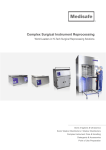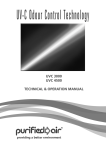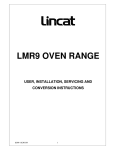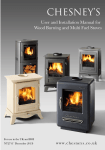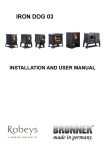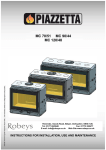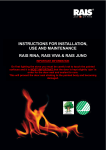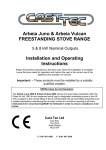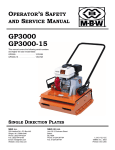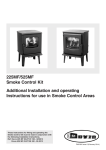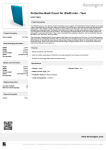Download Ekol Clarity Double Sided Manual
Transcript
EKOL CLARITY DOUBLE SIDED – INSTALLATION AND OPERATING INSTRUCTIONS.
INTRODUCTION
SAFETY
Safety is the most important consideration when using and installing your stove. If not installed and used correctly,
a house fire could result. Installation must comply with relevant national and local Building Regulations and fire
safety standards.
IN THE EVENT OF CHIMNEY FIRE, EVACUATE THE PROPERTY AND CALL THE EMERGENCY
SERVICES.
Your stove will be heavy and care needs to be taken when lifting - 2 people will normally be required to lift.
UNPACKING
Your stove will have several of its components stored inside the stove itself for transportation.
Do NOT drag the stove on its legs – it must be carefully lifted into place.
The flue spigot must be bolted to the flue outlet on the top of the stove.
Inside the stove you will find a glove which must be used when opening the door or when adjusting air vents when
the fire is hot.
INSTALLATION
Installation of your stove must comply with relevant local and national Building Regulations and fire safety
standards.
TECHNICAL
Model; “Ekol Clarity Double Sided”
Nominal heat output – 12.3 kW
Maximum Heat Output – 14kW
Gross Weight of Stove (inclusive of packaging) - 160 kg.
Net Weight of Stove – 137kg (low version), 152 kg (tall version).
Max Height - 598 mm (low version), 815 mm (Tall version)
Max Width - 625 mm
Max Depth - 515 mm
Flue Diameter - 150mm (6”)
Mean flue gas temperature directly downstream of the flue spigot – 431 degrees C. (with closed doors).
Flue gas mass flow – 8.4 g/s
Mean CO emission (at 13% Oxygen) –0.14 %
Net Energy Efficiency 73.3 %
The stove must not be installed within the specified minimum distances to combustible materials: A gap of at least
900mm needs to left between the stove and any combustible materials at the sides. Adjacent walls should be of
non-combustible materials and construction, preferably masonry or brickwork.
Your stove will require a constant air supply, and should not be used at the same time and in the same room/space
as extractor fans or any device which may draw air supply away from the stove.
The stove should be installed on a level floor with adequate load bearing capacity.
The stove needs to stand on a hearth of non-combustible materials not less than 12mm thick conforming to
Building Regulations.
NOT suitable for installation in a shared flue system.
If installed in a standard type chimney, a register plate needs to be fitted inside the chimney.
When purchasing flue pipe, 6” diameter is required. The flue pipe must be fitted INSIDE the flue spigot, and sealed
with a generous amount of Fire Cement.
Access should be provided for cleaning the flue gas connector and chimney flue to ensure that the passageways for
exhaust gases remain free from obstruction.
We recommend that you have a qualified fitter install your stove. The British recognised standard for solid fuel
installations is HETAS. You can find a HETAS qualified installer in your area by going to the HETAS website –
www.hetas.co.uk.
OPERATING INSTRUCTIONS
The Clean Air Act 1993 and Smoke Control Areas
Under the Clean Air Act local authorities may declare the whole or part of the district of the authority to be a
smoke control area. It is an offence to emit smoke from a chimney of a building, from a furnace or from any fixed
boiler if located in a designated smoke control area. It is also an offence to acquire an "unauthorised fuel" for use
within a smoke control area unless it is used in an "exempt" appliance ("exempted" from the controls which
generally apply in the smoke control area).
The Secretary of State for Environment, Food and Rural Affairs has powers under the Act to authorise smokeless
fuels or exempt appliances for use in smoke control areas in England. In Scotland and Wales this power rests with
Ministers in the devolved administrations for those countries. Separate legislation, the Clean Air (Northern Ireland)
Order 1981, applies in Northern Ireland. Therefore it is a requirement that fuels burnt or obtained for use in smoke
control areas have been "authorised" in Regulations and that appliances used to burn solid fuel in those areas (other
than "authorised" fuels) have been exempted by an Order made and signed by the Secretary of State or Minister in
the devolved administrations.
The “Ekol Clarity Double Sided” has been recommended as suitable for use in smoke control areas when burning
seasoned wood.
Further information on the requirements of the Clean Air Act can be found here : http://smokecontrol.defra.gov.uk/
Your local authority is responsible for implementing the Clean Air Act 1993 including designation and supervision
of smoke control areas and you can contact them for details of Clean Air Act requirements.
FUEL
Wood- All types of wood are suitable provided they are wells seasoned, UNTREATED, and have a moisture level
between 12% and 20%. For soft woods, typically they will need to have been left in suitable storage for 9+ months
in order for the moisture to evaporate. For hardwoods, this will usually be 18 months+. It is recommended that logs
should be no more than 5” or 125mm in diameter. Logs should be no more than 450mm in length. If you are unsure
of the moisture content of your fuel, then you can buy a moisture meter which will indicate the moisture levels in
your fuel.
Liquid fuels must NEVER be used.
WARNING: Wet timber should not be used as this will create excess tar deposits in the chimney and stove and
could increase the risk of chimney fire. Timber which is not of a suitable moisture content will also create more
smoke and harmful emissions.
Manufactured smokeless coals and anthracite can be used and will all have different qualities and effects. – Do
NOT use Petro-Coke based fuels or any petroleum based fuels as this will invalidate the warranty. Never use your
stove as incinerator to burn waste or rubbish. Any coal burned should be coal suitable for a multi-fuel stove (some
coal is only for use on open fires and burns too hot for a stove).
Never use your stove as incinerator to burn waste or rubbish.
AIR INLET CONTROLS
Your stove has four sets of air inlet areasThe upper vent above each door provides air supply for the air-wash system and allow air into the higher areas of
the fire box – this is called the Secondary air – when this vent is open, the door glass is kept clean by high speed air
rushing downwards across the inside of the glass. By moving the Secondary vent knob to the right, airflow into the
stove is increased. The secondary air vent is set such that the closure plate does not seal fully, thus allowing some
constant air supply into the stove.
The lower vent knob on the bottom of the door controls the provision of Primary air – this is the primary source of
air supply for combustion. Sliding the knob to the right increases the amount of Primary airflow into the stove.
The third (Tertiary) vent control is located underneath the stove and controlled by a lever/ knob tucked under the
bottom shelf. Pulling the lever out increases the airflow into the stove. The air is then channelled through a
chamber on the bottom of the stove and to the sides of the firebox, and enters the firebox via a series of small
holes. Pushing the lever fully in closes of this air intake partially. This intake cannot be fully closed. This ensures
the stove maintains level of combustion not likely to create excessive smoke.
TOOLS
The glove is provided for adjusting the air inlets and for opening the door when the stove is hot, as these knobs will
heat up when in use. NOTE – all parts of the stove will become hot during use and care needs to be taken to
avoid injury through burning.
LIGHTING THE FIRE
Prior to lighting the fire for the first time, ensure thatInstallation and building work is complete.
The chimney is suitable and sound and has been swept and free from obstruction.
Adequate ventilation and provision for combustion air has been made.
That the stove installation has been carried out in accordance with Building Regulations and any applicable
local regulations as well as these installation instructions.
That chimney draw has been checked and within specification. (The stove has been tested at nominal
output with a flue draught of 12 Pa) Flue draughts in excess of 18 Pa when warm will have a negative effect
on the efficiency, could cause premature wear and damage to the stove.
ENSURE THAT YOU HAVE READ AND UNDERSTOOD THESE INSTRUCTIONS BEFORE LIGHTING
THE FIRE, AND THAT YOU ARE CONFIDENT THE STOVE HAS BEEN INSTALLED CORRECTLY.
ALWAYS WEAR A PROTECTIVE GLOVE WHEN REFUELLING YOUR STOVE.
Ignition (When New)
On day one, a curing procedure for the curing of paint must be followed:
3 small fires each with kindling and a couple of half normal size logs should be burnt, each lasting approx. 45
minutes to 1 hour. Between each fire, allow the stove to cool down slightly, allowing approx. 40 minutes cooling
between each fire.
After all three fires, allow to cool completely, then a normal fire can then be lit allowing the stove to get up to
normal temperature. Following this procedure will help the paint to cure properly, prolonging the life of the paint
surface.
Ignition (On-going, once above procedure has been followed)
Ensure all air inlets are fully open.
Construct a pile of kindling in the middle of the grate using approximately 1kg (approx. 2 handfuls) of
kindling wood.
Light with a single chemical firelighter.
Partially shut the door but leaving it cracked open slightly.
After about 5 minutes or when the fire is well established, shut the door.
After a further 3-5 minutes as the fire starts to die, add a further three or 4 small logs weighing approx 1.5
kg total.
Once theses logs are alight, and after about 7 minutes or so, a normal load of 3 or 4 logs weighing
approximately 3 kgs in total can be added.
Once this load is burning well, the Primary air vents can be closed, with the Secondary and Tertiary vents
left open.
Refuelling
Open the Primary air vents.
Add up to 3 kg of wood.
After about 2 minutes or when flames from the fresh fuel fully established, close the Primary vents.
At high power output, your stove will require refuelling approximately every 45 minutes.
It is important to follow these instructions in order to achieve clean burning and to maximise the efficiency
of the stove.
Do not leave the fire unattended until flames are well established on the newly charged logs.
Always refuel onto hot embers.
Reduced burn rates can be achieved by reducing the openings of the Secondary and Tertiary air vents.
Refuelling on to a low fire bed
If there is insufficient burning material in the fire-bed to light a new fuel charge, excessive smoke emission
can occur. Refuelling must be carried out onto a sufficient quantity of glowing embers and ash that the new
fuel charge will ignite in a reasonable period. If there are too few embers in the fire bed, add suitable
kindling to prevent excessive smoke
Fuel overloading
The maximum amount of fuel specified in this manual should not be exceeded, overloading can cause
excess smoke.
Operation with door left open
Operation with the door open can cause excess smoke. The appliance must not be operated with the
appliance door left open except as directed in the instructions.
Dampers left open
Operation with the air controls or dampers open can cause excess smoke. The appliance must not be
operated with air controls or dampers door left open except as directed in the instructions.
UK Clean Air Act 1993 - Smoke Control Areas
The Ekol Clarity Double Sided wood-burning stoves are suitable for use in smoke control areas when used in
accordance with these instructions.
WARNING- The high temperature paint covering the stove will give off some fumes during the initial few uses of
the stove. The fumes are non-toxic, but some people may find them unpleasant – Ensure the area is well ventilated
during this period.
The output ratings of this stove are based on around 3kg of seasoned logs which would require refuelling every
hour.
This stove is suitable for intermittent burning, and should not be used constantly for extended periods. Not suitable
for overnight burning.
Under certain abnormal weather conditions, e.g. down draughts, it may be difficult to get sufficient draw through
the appliance to achieve good combustion. When this happens, the stove should not be used.
CLEANING/MAINTENANCE
Regular cleaning of the stove is essential for safety and efficiency. The ash should be emptied at least after every
use, and during use if burning for longer periods.
When cold, the inside of the stove should be given a regular sweep out.
The flue and flue pipe will require cleaning with a suitable chimney brush, to minimise build up of soot and tar.
You chimney will also require periodic sweeping.
If the glass becomes stained from the inside, the air-wash vent may need opening more during use.
The high temperature paint which your stove is finished in should last many years with normal use, but when it
does eventually require re-finishing, black heat resistant paint in spray cans can be purchased from most hardware
stores. – Do not use regular paint which is not high temperature resistant.
Occasionally the paint can peel if the surface has not cured properly on the first burns when new. In this instance,
continue to use the stove until all damaged paint has become apparent – this may take several weeks. When you are
confident all damaged non-cured paint is loose, it is easy to refinish the affected areas using suitable hightemperature paint in a spray tin.
After prolonged periods of not using the fire, the stove and flue system should be checked for blockages prior to relighting.
We recommend regular servicing and safety checks are carried out by a qualified engineer.
There must be no unauthorised modification of the appliance. Use only replacement parts recommended by the
manufacturer.
GUARANTEE
The main body of your stove is guaranteed for 5 years when all guarantee terms are followed including registering your guarantee via the website
within 30 days of purchase. Please register here: http://www.defrastoves.com/guarantee-registration.htm Failure to register within 30 days will
limit your guarantee to 12 months from date of purchase. This does not include glass, grates, inner linings/firebricks, door seals, over-firing
incorrect use or installation not carried out by a competent person or in accordance with building regulations. – You should have zero problems
with your stove unless it is abused and if treated well your stove will last and last.
What to do in the event of a chimney fire:
cut off the air supply to the stove, i.e. close the primary and secondary air supplies
move any combustible materials well-away from the stove
get everyone out safely
make sure that the fire brigade has clear access
call 999 If you have any questions or concerns regarding the safe use of your stove, please contact us.








